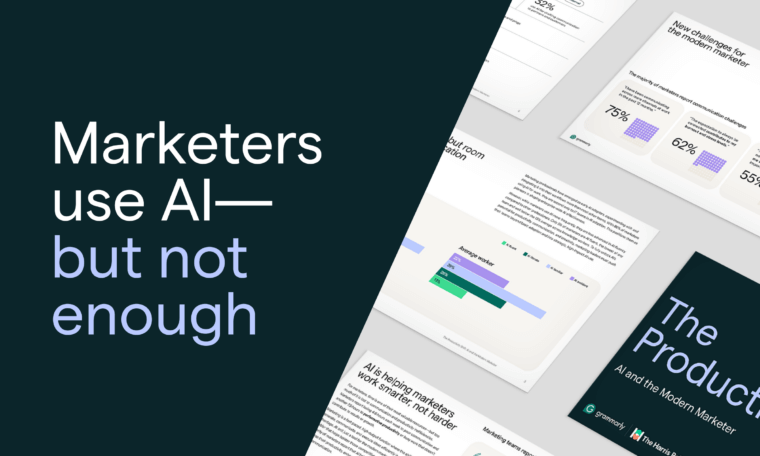Businesses are moving fast to implement generative AI, but new research suggests that employees are moving even faster. A Forrester study commissioned by Grammarly shows that 70% of respondents use gen AI for most or all of their writing and editing at work. Among those that are using gen AI for all of their writing, 80% report that their company has not yet implemented gen AI.
This means that people are not waiting for their company to adopt gen AI. They are using it right now—and at a high frequency.
Rushing to implement gen AI with a shortsighted strategy that accommodates individuals or departments with their own tailored solutions is not the answer. Instead, organizations must move deliberately and swiftly toward an enterprise-wide strategy.
The risk of moving too slowly: shadow AI
As the Forrester data shows, people are already using gen AI in the workplace—even if their company hasn’t officially implemented it yet. In fact, at the time of the survey, only 26% of respondents’ companies had implemented gen AI. And while the majority (97%) of businesses will have implemented gen AI by 2025, most organizations are chasing behind their employees.
It’s no surprise that people are clamoring to use gen AI in their day-to-day work. While the technology itself was not new, the release of several practical gen AI applications beginning in late 2022 demonstrated the immediate and tangible possibilities of gen AI. People experimented with prompting the applications to generate first-draft content, jump-start ideas, summarize emails, create outlines, and more. The Forrester data shows that these early forays with gen AI tools are already enabling people to work faster. On average, respondents reported a daily time savings of 33% from using gen AI at work—the equivalent of 2.5 hours a day and 13 hours a week now freed for individuals to focus on even more valuable activities.
However, while employees are benefiting from the technology, the ungoverned use of gen AI tools, known as “shadow AI,” opens businesses up to preventable risks. Some of the most common risks associated with shadow AI are sensitive data being leaked to third parties, intellectual property being exposed to competitors, and inaccurate content being shared outside the organization.
It’s essential that organizations move quickly to develop an enterprise strategy. If they don’t, they risk gen AI happening to their organization rather than for their organization.
The risk of moving too quickly without a strategy: technical debt
Most of the Forrester respondents (72%) report that different departments are implementing gen AI on their own without an organization-wide strategy. In other words, these companies do not have a plan in place for how gen AI tools fit into a broader data and analytics ecosystem. These multiple, separate implementations create the risk of technical debt in the future when IT teams attempt to connect many disjointed tools into a manageable and trackable system.
A fragmentary approach to gen AI implementation also limits the scalability—and therefore the transformative impact—of gen AI in the enterprise. The Forrester data shows that the majority of respondents expect gen AI to have a transformational or large impact on company culture (79%), customer experience (77%), and operational costs (75%), to name a few. But for gen AI to reach its full potential, the business must be able to easily adapt its deployment of gen AI over time as the technology continues to evolve.
The Forrester data shows that companies with an enterprise-wide gen AI strategy are 2.6 times more likely to be expanding or upgrading their implementation than those with line-of-business or departmental implementations. Further, those with an enterprise-wide strategy are 1.4 times more likely to be adopting gen AI at an accelerated pace.
Selecting the right gen AI partner to deploy an enterprise strategy
To achieve a company-wide gen AI strategy, businesses must invest in scalable solutions that support multiple use cases across the organization and meet enterprise-grade standards for privacy and security.
Stand-alone gen AI applications that only work for one team or department not only create a tangled IT mess but also limit the potential of gen AI to transform workflows across the organization. Nine out of 10 respondents reported that their companies need a gen AI solution that can be used across the organization, not limited to a few departments or functions.
To facilitate an enterprise-wide approach to gen AI, businesses should invest in solutions that support cross-functional collaboration and integrate with the applications and systems employees already use. For example, Grammarly Business works across more than 500,000 applications and websites that employees are already working within in order to support communication across virtually every workflow.
Grammarly Business also supports enterprise needs by ensuring gen AI outputs are on-brand and contextually relevant. Eighty-nine percent of respondents indicated that gen AI solutions must understand the context of many different scenarios for it to hold value.
Taking the right next step
The majority of Forrester respondents said that their business is moving at the same speed or faster to adopt gen AI than with previous technology innovations. With so much enthusiasm behind gen AI, it’s essential that your organization take the right first steps with a holistic strategy.
Those that move too quickly without an enterprise approach risk falling behind with deployment strategies that will limit the transformative potential of gen AI.
To learn more about Grammarly’s gen AI solution and how it can enable your entire organization to accelerate ahead, click here to get in touch with a product specialist.



